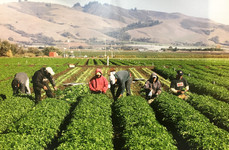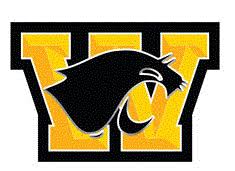Watsonville CA: Berries, Unions, Sneakers & Ambitions
- Sarah Stookey
- Nov 17, 2018
- 7 min read
Updated: Dec 5, 2018

Watsonville CA is located in the Pajaro Valley, on a plain between the Pacific Ocean and the Santa Cruz Mountains, 95 miles south of San Francisco. I spent several days in and around Watsonville, working with students at Watsonville High School, Cabrillo Community College (in nearby Aptos) and Mt. Madonna High School in the mountains above the town.
Prior to the Spanish conquest the Pajaro Valley was settled by the Ohlone people. The climate is very well-suited to agricultural production and in the mid-1800s European immigrants established farms. Since then production is increasingly focused on berries (strawberries and raspberries - Watsonville is often described as "The Strawberry Capital of the World"), apples and ornamental plants.
Strawberries produce high revenues on relatively small acreage and are the fourth most valuable crop in California. A 2016 University of CA Davis study calculated profits of up to $53,500 per acre. Production is labor intensive. Non-supervisory farm labor represents 36.5% of total costs (Farm supervisory labor is 1.47%). "Labor rates are estimated at $21.70 per hour for machine operators and $16.10 for field labor, which includes overhead of 40 percent. The basic hourly wages are $15.50 for machine operators and $11.50 for field labor. Harvest crews are often paid a base wage plus piecework rate, or straight piecework depending on the time of harvest." (all data cited and calculated from UC Davis report).
Murals, photographs and paintings from Watsonville Public Library
Since the beginning of commercial agriculture in Watsonville, farm labor has been supplied by immigrants: "Croatian and Irish and other European immigrants worked the fields in the 1800s, followed by waves of Chinese, Japanese and Filipino immigrants at the turn of the 20th century through World War II. It wasn’t until the end of the Bracero program in the 1960s that the migrant Mexican farmworkers who came to Watsonville during picking season brought their families and settled down...leading to the community’s (current) 80 percent Latino population." (Santa Cruz Sentinel, 3/25/18)
The concentration of immigrant labor and exploitative treatment by growers in agricultural regions of California, including Watsonville, led to the formation by Cesar Chavez of the United Farm Workers (formerly National Farm Workers Association) in 1962.
Photo, Cesar Chavez in Watsonville, 6/1985, S.C. Sentinel. Mural, Watsonville Public Library
In 1974, after five days of strike, the UFW won the first collective contract for Watsonville strawberry workers, gaining a 20% increase over previous wages (UFW newspaper, El Malcriado, 5/29/74). For a sense of the early era of this labor organizing see"Reflections of a Union Organizer: Watsonville, CA" and video of early marches. Farmworkers' struggle for better wages and working conditions has continued up to the present. See, for example, video of labor confrontations on Watsonville strawberry farms in 1998 and recent organizing victories for raspberry workers who obtained their first union contract in 2017.
Watsonville High School (the Wildcatz) enrolls 1,925 students. 98% of students are characterized as "minority", and 81% as "economically disadvantaged" (U.S.News).
The campus and playing fields are spread over several downtown blocks. Students are organized into eight Small Learning Communities (SLCs), each with a distinct content focus. I worked with two 90-minute classes of 10th graders in the ECHO (Education, Community, Humanitarian, Outreach) SLC. They were enrolled in ECHO teacher Madison Gipe's Perspectives in Education course which focuses on preparing students for careers (in teaching and others) and for post-secondary education.

My impression of the school from my brief time there was of faculty and staff dedicated to supporting students, including helping to facilitate college admissions for those whose families may not have the experience or resources to do that. See, for example, the resources described on the school's post-secondary guidance webpage, including detail about the University of California system and an "Ivy League Project". On the day I visited there was encouragement to participate in school-sponsored trips to visit nearby colleges, student internships within the school itself and community engagement activities (like a trip to read aloud with elementary school students).
I was with two classes of students for 90 minute periods which works much better for talking capitalism than the 55 (or even 45) minute periods I found in some schools. In each class (about 30 students each) we did what has become my standard gig: we start out talking about my trip and why I think it's important for people to talk about capitalism. I ask how many of them have heard the word before (most have) and whether they think they live "in" capitalism (many think they do). Then we talk about how often we don't openly talk about very familiar aspects of life. Why, I ask fish - if they could talk - wouldn't be able to tell you what water is (students seem to enjoy the fish in water idea).

Then I asked them to write down what "capitalism" means to them, being clear that it's fine to say "I don't know". Unfortunately, the first class was interrupted near the end by an earthquake drill - more on that below - and by the time it ended it was the next class period and and I wasn't able to collect the students' writings. I ask them to share their ideas and try to put together a general idea from their contributions. Here are some of the responses from the second group of 30 students:
Some version of "I don't know" (16 students)
"power"
"the word capitalism means citizens feeling unhappy"
"Capitalism has to do with the economy and how systems work within a country, states, etc."
"I think it's about money, and how it affects the economy, or how we use it"
"I think the word capitalism has to do something with business"
"a system in which is either bought or sold"
"Capitalism means the way money travels through business (I'm guessing)"
"The economic and political system in which a country's trade and industry are controlled by private owners for profit" (!)
"the cycle of money in a city"
"I think capitalism has to do with money"
"To capitalize a word in a sentence"
Then I "walk" through the capitalism diagram on the board (they also have handouts of it they can refer to and make notes on), frequently asking them to contribute examples. For example, we talk about how businesses produce "value" and how that can be in the form of goods or services and we make lists: What's a good? Your jacket. What's a service? A haircut.
I explain what capital is (a "special kind" of money, that makes more money) and we go through some examples of money they're familiar with, together deciding whether it's capital or not. Money your family uses to pay the rent? Not capital. Money a landlord invests in a building to rent out apartments to people? Capital. Money you have in your pocket to get pizza with friends? Not capital. If you took the same money and bought a package of T-shirts at Walmart and spent the weekend drawing designs on them and sold them to your friends at school on Monday? Capital.
We also talked different ways capital is invested. I asked them about businesses they might like to start someday, or businesses they know people have. Barber shops came up. Also, Ms. Gipe reminded one boy that he wanted to start a car detailing business. So we talked about what you would use capital for if you were starting a car detailing shop, the kinds of equipment and space you'd need. And how a barber who owns his shop is doing the work and also getting the profit. And then we talked briefly about how capital can also be invested in big companies like Amazon. I drew a grid on the board and explain how a person can buy a share, or a partial share of the company and then also get a small share of the profits. This, I explain, is what happens on Wall Street (which some of them have heard of).
In the discussion of work I asked them, as I usually do, if they had jobs. About half the students (these are younger teenagers, about 15) said they did. We talked about what it is we do when we work, how we use our bodies, hands, brains and hearts, how people are different than machines at work (I often end up using "magic" to describe what people have in them that's special). They could think of examples of things that people can do that machines can't: move easily through crowded spaces, observe when someone is grouchy, make friends. We talked about how human interactions can be important in business, how they can help make profit.
I didn't introduce the topic of agricultural work and students didn't bring it up. So it was notable when Ms. Gipe told me later that many of the students regularly work on the weekends picking strawberries. Under California law, the minimum age for children to do agricultural work outside of school hours is 12.
At the end of each class period I asked the students to fill out the other five questions on the handout. Students in the second class period responded to the question "What would you change?" by focusing on pay and taxes:
"I would change how much a person is being paid or allow everyone to work the say pay if they are doing the same thing"
"I would change how others have better opportunities than others"
"equal pays"
"the amount of taxes people pay"
"nothing because capitalism is its own thing"
"idk"
"what I would change is not getting payd as good as others just because of race, skin color, or gender"
"I don't think I would change anything"
"I would change the way people are paid like I would only base it on their education or skills"
"I would change about capitalism is to make things easier"
"I would change the fact that people get low pay because they aren't educated"
"I would change the wage for workers and the taxes"
"I would let people decide where the taxes should go"
The handout included a space for them to draw their own pictures or diagrams of capitalism and some of them did:
About that earthquake drill at the end of the first period (I was sorry not to be able to collect those students' papers; they were a very engaged group). The students organized peacefully on the playing fields. Thankfully it was a lovely day but the fields had recently been watered and were squishily wet. Many students were understandably concerned about their shoes. Some boys from the class and I found a sort of dry patch and they explained that their sparklingly white shoes would yellow if they got wet. We chatted about investing (one of them was particularly interested in bitcoin) until the all-clear bell rang.
I very much enjoyed working with the Ms. Gipe and her students at Watsonville High School. These young people impressed me with their awareness of the workings of the economy, their creative energy and their willingness to engage with me. Thank you, to them and to Principal Elaine Legorreta, for giving me the opportunity!































































Comments